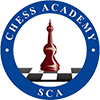What is an SCA rating?
SCA’s chess rating system is used to estimate the strength of a player, based on their performance versus other players. A similar system is used by FIDE (The International Chess Federation) as well as other chess organizations.
How to get a starting SCA rating?
All participants of SCA chess academy’s tournaments are eligible to get the rating.
Entering a tournament:
the starting rating for Beginner level students is 1000.
the starting rating for Intermediate level students is 1100.
the starting rating for Advanced level students is 1200.
How to calculate an SCA rating change?
A higher number indicates a stronger player. The lowest possible rating is 1000. A player’s rating depends on the ratings of their opponents and the results scored against them.
After every game, the winning player takes points from the losing one, and the number of points is determined by the difference in the two player’s ratings:
If the higher-rated player wins, a few points are taken from the lower-rated player.
If the lower-rated player wins, a lot of points are taken from the higher-rated player.
If it’s a draw, the lower-rated player gains a few points from the higher-rated player.
The magnitude of the change also depends on the k-factor.
What is the k-factor?
To put it simply, the K-Factor is a cap on how many rating points a player can win or lose from a single match. The K-Factor is a critical part of maintaining an accurate rating.
A new player is given k=40, which gives him a chance to get/lose up to 40 rating points in one game. Such a big k-factor allows new players to get a high rating quite fast.
As the rating goes up, the k-factor goes down. A smaller k-factor minimizes the perturbation of the rating change which makes the rating more representative and stable.
K=40 for players with rating 1000-1399
K=30 for players who reached the threshold of 1400
K=20 for players who reached the threshold of 1600
In the long run, the rating system is self-correcting and ratings eventually settle to the correct value. Students are advised to participate in as many rated tournaments as possible, so the rating becomes more “meaningful”.
Calculating chess rating
Example 1
Consider a game between two players with the same rating under 1400. The k-factor is 40 for both players, and, therefore, the winner of the encounter gets 20 points of rating whereas the loser loses the same amount of rating points.
Example 2
Consider a game between two players with the same rating above 1600. The k-factor is 20, and, therefore, the winner of the encounter gets 10 points of rating whereas the loser loses the same amount of rating points.
Example 3
Consider a game between two players, A and B.
A’s rating is 1300 and the k-factor 40.
B’s rating is 1500 and the k-factor 30.
If A wins the game, then A gets 30 rating points, however, player B loses only 23 rating points, not 30. Inconsistency in win/lose rating is due to the difference in players’ k-factors.
How many games do I need to play to get a “meaningful” rating?
Students are advised to participate in as many rated tournaments as possible. By doing so players’ ratings will become more comparable and representative.
To speed up the process of obtaining a “meaningful” rating, a new student’s first rating change will be calculated based on the rating performance, not the rating change described above.
What is the rating performance?
It is the rating a player would have if his actual score was the expected score he would get against his opponents based on his opponent’s individual ratings.
A new student should play at least 5 games to get a rating performance. A new rating will be equivalent to a rating performance, however, a new rating cannot exceed 1300. Players whose ratings drop below 1000 are treated in the same manner as any other new student.
Are all tournaments rated?
A tournament is rated if the total length of time available to both players (assuming an average game length of 60 moves) is not less than 20 minutes. For example, if the time control is 8min+2sec, then the total available time is:
(8min + 2sec*60) * 2players = 20 minutes available to both players.
Similarly, 7min+3sec gives the same result:
(7min + 3sec*60) * 2players = 20 minutes available to both players.
Live list of players
To be on the live list of active players one should play at least one rated game a year.
SCA titles and norms
To qualify for an SCA lifetime honorary title of Chess Conqueror, CC, one should meet the following criteria:
An CC norm is a high level of performance in a tournament with at least 20 participants. A player will be awarded a CC norm after showing a rating performance of at least 1400 or above in a given tournament.
To qualify for an SCA lifetime honorary title of Chess Ambassador, CA, one should meet the following criteria:
An CA norm is a high level of performance in a tournament with at least 20 participants. A player will be awarded a CA norm after showing a rating performance of at least 1550 or above in a given tournament.
